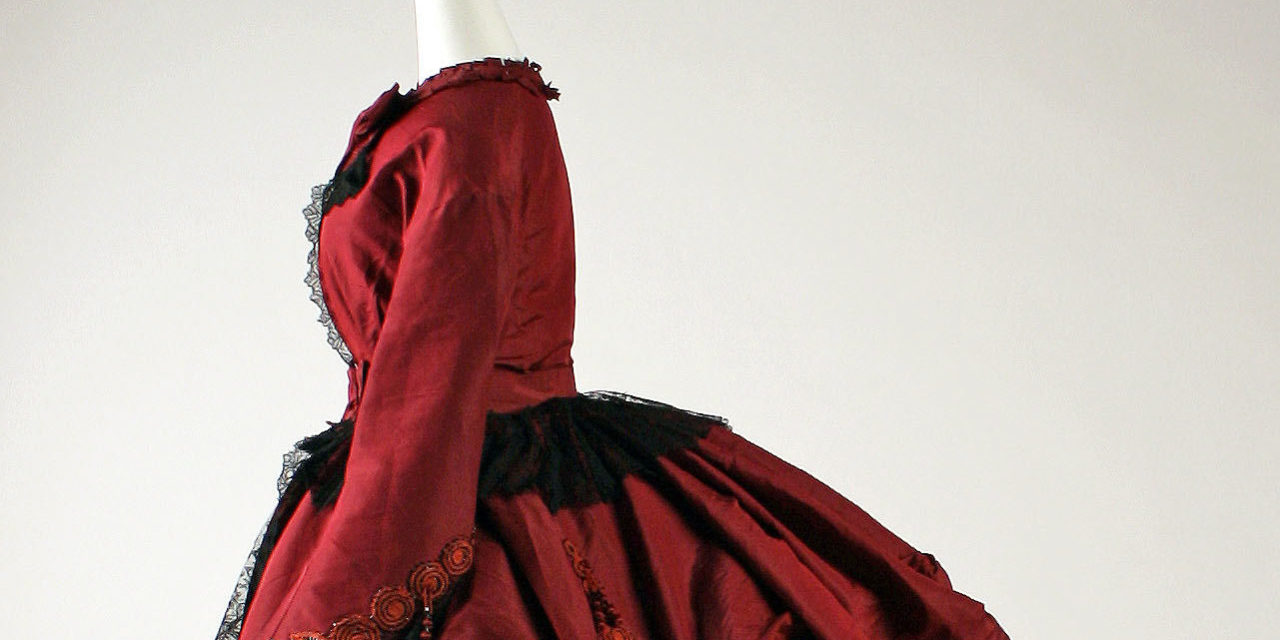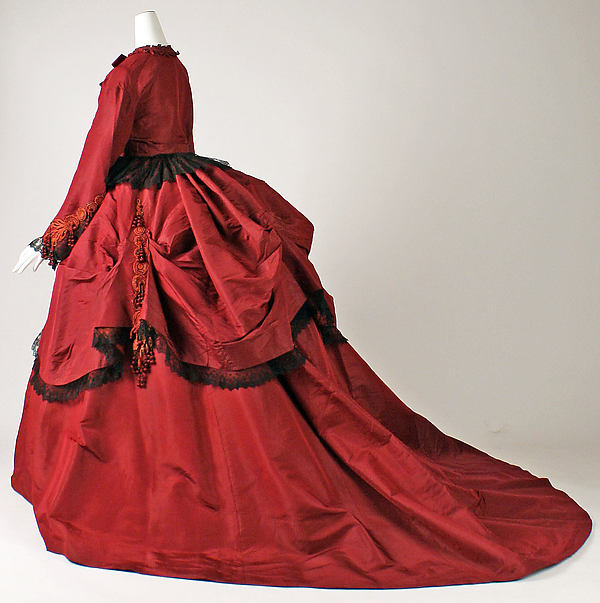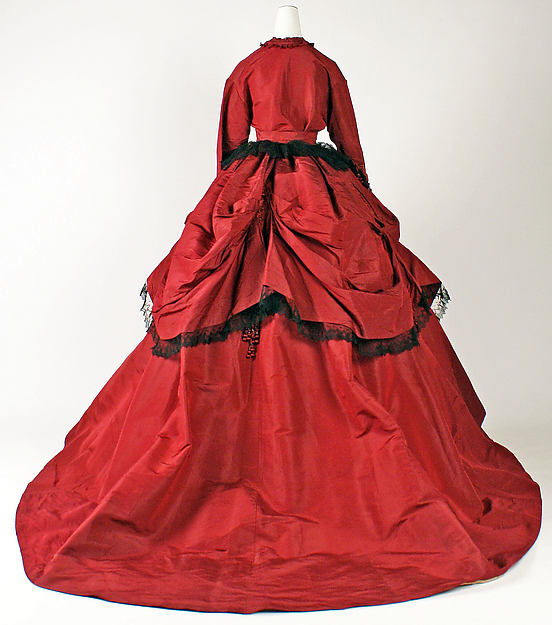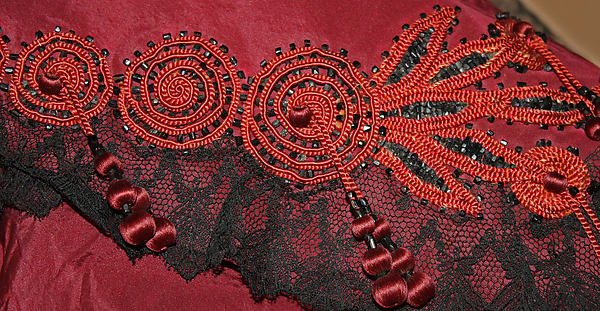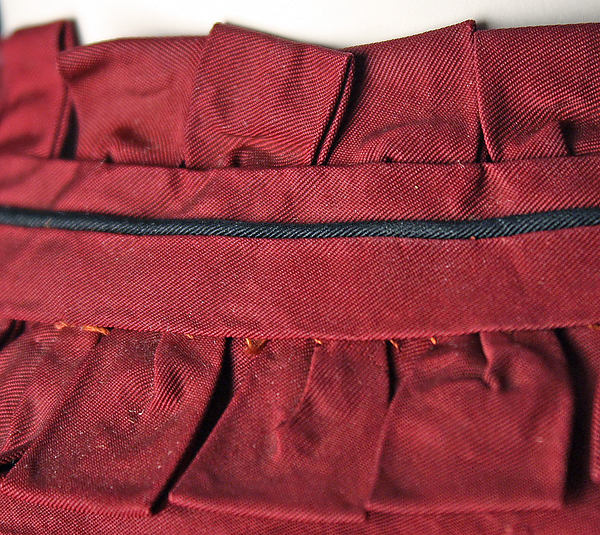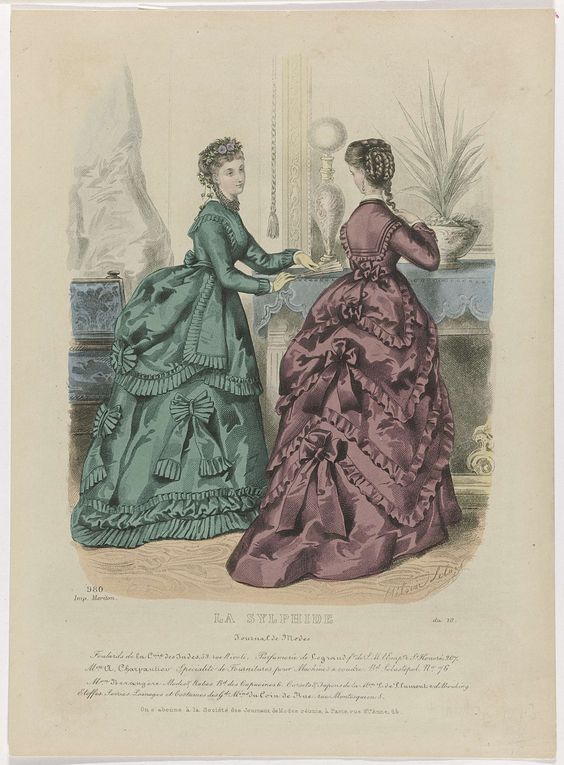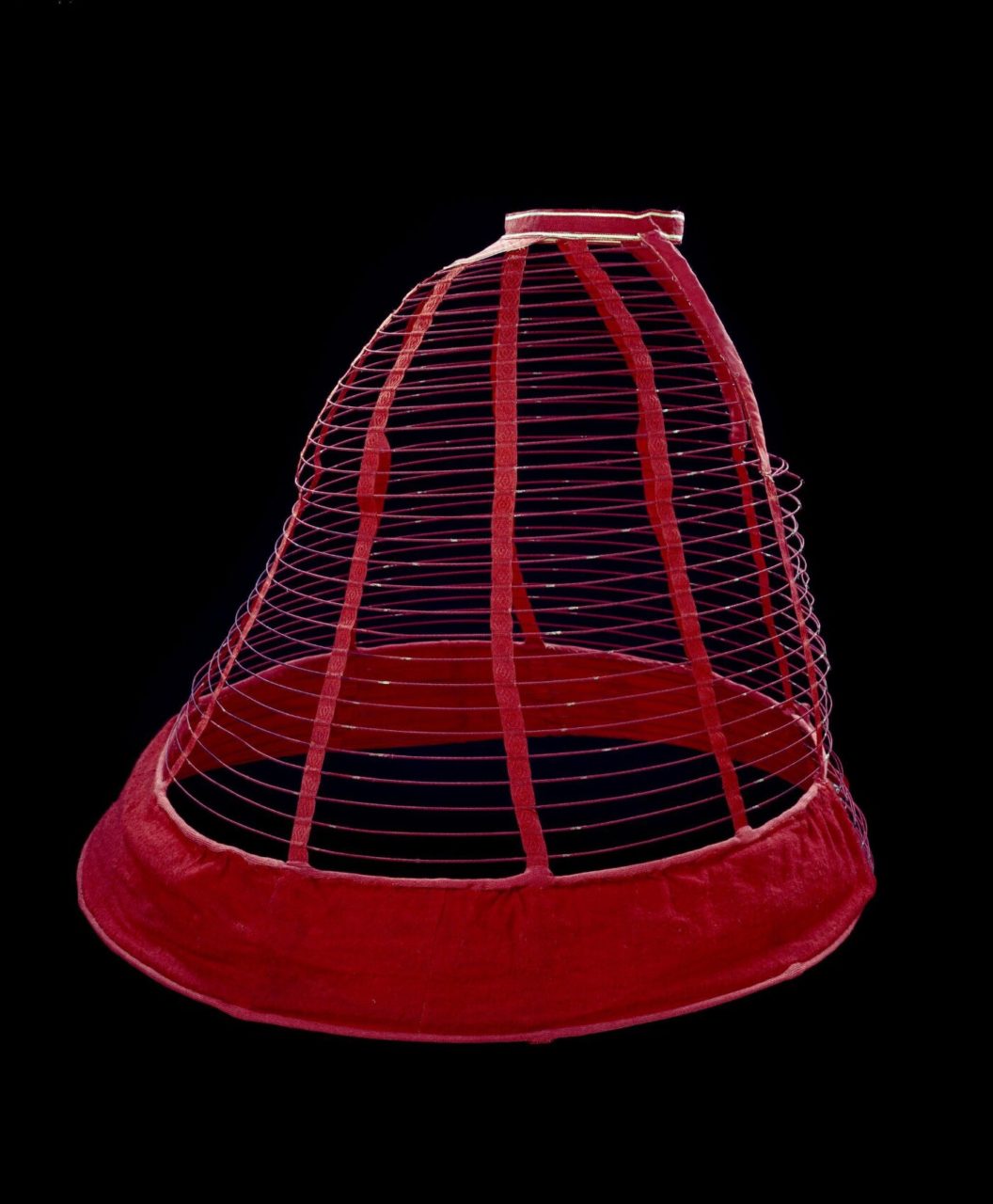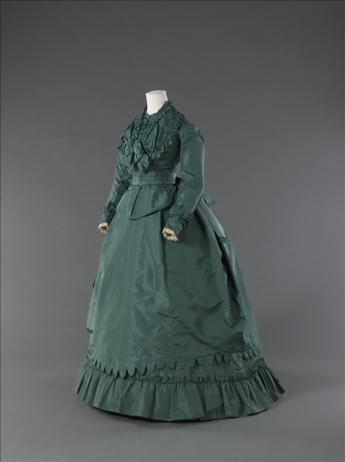This red silk dress embodies the late 1860s transition in fashion towards the bustle and the period’s taste for bold colors and intricate detailing.
About the Look
T
his 1869 red silk day or dinner dress is intricate, alluring, and especially bold when seen from the side (Fig. 1) and back due to its large bustle and extended train (Fig. 2). The fitted waist, accented by the bustled overskirt with black lace trimming emerging underneath, blooms out into a draped skirt and creates a puffed effect, embodying the transition in fashion from crinoline to bustle in the late 1860s.
The black floral lace appliqué along the arms of the long sleeves are paired with passementerie, tassels and beading (Fig. 3). The black lace that extends from underneath the cuffs to cover the hands of the wearer is a delicate and striking touch juxtaposed with the solid, shocking red silk of the rest of the gown. The same lace that decorates the edges of the collar also decorates the sleeves, the skirt, and the waist. The tassels and beading also repeat on the back and sides of the skirt as well, bunched-up and tucked-in for a sense of careless perfection. The silk appears to be a twill weave (Fig. 4), durable and less shimmery than a satin or velvet.
Fig. 1 - Designer unknown (American or European). Dress, 1869. Silk. New York: The Metropolitan Museum of Art, 2002.383a, b. Purchase, Irene Lewisohn Bequest, 2002. Source: The Metropolitan Museum of Art
Fig. 2 - Designer unknown (American or European). Dress, 1869. Silk. New York: The Metropolitan Museum of Art, 2002.383a, b. Purchase, Irene Lewisohn Bequest, 2002. Source: The Metropolitan Museum of Art
Fig. 3 - Designer unknown (American or European). Dress, 1869. Silk. New York: The Metropolitan Museum of Art, 2002.383a, b. Purchase, Irene Lewisohn Bequest, 2002. Source: The Metropolitan Museum of Art
Fig. 4 - Designer unknown (American or European). Dress, 1869. Silk. New York: The Metropolitan Museum of Art, 2002.383a, b. Purchase, Irene Lewisohn Bequest, 2002. Source: The Metropolitan Museum of Art
Dress, 1869. Silk. New York: The Metropolitan Museum of Art, 2002.383a, b. Source: The Metropolitan Museum of Art
About the context
While describing a similar dress in their collection (Fig. 5), the Met helpfully summarizes the fashions of the time:
“By 1866, fashion had decreed that the fullness of the skirt should be gathered up somewhat at the back, and that an overskirt should be added to the full skirt. In 1868, the great expanse of the skirt narrowed considerably at the side, giving a much straighter silhouette in front; the fullness now moved to center back, where the primary shaping was provided by the bustle.”
The move towards the bustle can be seen in figure 1 with the round, extended skirt back and a gentler style can also be seen in fashion plates of the time (Figs. 6 & 7). This silhouette was supported by a light boned understructure called an elliptical crinoline (Fig. 8) or crinolette, depending on its size.
Fig. 5 - Designer unknown (British). Dress, ca. 1870. Silk. New York: Metropolitan Museum of Art, 1980.409.1a–c. Catharine Breyer Van Bomel Foundation Fund, 1980. Source: MMA
Fig. 6 - Artist unknown. Women 1869, Plate 023, 1869. I. Gift of Lee Simonson. Source: Costume Institute Fashion Plates
Fig. 7 - Artist unknown. La Sylphide/Journal de Modes, 1869. Engraving on paper; 2.94 x 2.15 cm. Amsterdam: Rijksmuseum. On loan from the M.A. Ghering-van Ierlant Collection. Source: Rijksmuseum
Fig. 8 - Designer unknown (British). A Favorite Of The Empress, 1860-65. Spring steel, woven wool, linen, lined with cotton, and brass; bottom circumference 235 cm. London: Victoria & Albert Museum, T.150-1986. Given by Mrs A. E. Valdez. Source: VAM
This silhouette was popular in 1869, as a writer in Peterson’s Magazine wrote under “Fashions for June”:
“The skirt is long, and is trimmed with several flounces, and is caught up by bows of black velvet. There is a full puff at the back, with a large bow at the waist. The high waist is trimmed square, with a ruffle.” (479-80)
A high waist, puffed bustles, bows, and ruffles (Fig. 6) were notable characteristics of dresses in the late 1860s and early 1870s. Bodices also tended to be heavily adorned and waistlines were slowly moving upwards. The gown in figure 9 sports a noticeably above-waist waistline coupled with a false-jacket front (revers) and a large self-fabric bow at the center of the chest. However, the newest fashions were for a slightly more restrained silhouette and a more heavily decorated skirt and torso (Fig. 10). The Worth & Bobergh example in figure 11 is dated slightly earlier, 1867-70, as it displays the wide and unrestrained skirt and a less heavily-decorated bodice just as the Met example does.
The dress in figure 10 lacks a train, pointing to its suitability as a walking or promenade costume (Edwards 100). In Fashion in Costume, 1200-2000 (2000) Joan Nunn discusses the changes in fabric and color during this time:
“Throughout the period light colours were fairly general for evening wear and were considered more suitable for young ladies, as were cottons like muslin or tarlatan, but by the 1860s cotton had lost ground as a high-fashion fabric, and silk, satin, taffeta, faille, moiré, silk poplin from Ireland, and velvet for more mature ladies, were used for formal dresses.” (166-67)
Red was a relatively common color at this time among the elite due to its richness, especially when created through the new aniline (synthetic) dyes that evoked novelty and opulence. In the sunny French beach scene in figure 12, at least three of the women gathered are wearing red dresses.
According to Godey’s Lady’s Book & Magazine in “Chitchat: Fashions for February” (1869):
“Never has fashion shown itself so capricious as this season… The short-dress is worn in demi-toilette and for promenade costume… Trains appear to have grown longer, because they are worn over small hoops.” (201)
Around this time, as Godey’s discusses above, most women wore dresses with no trains; instead, they opted for shorter dresses which would allow them to show off their shoes (Fig. 6) and be easier and cleaner to walk around in (see Fig. 12).
This dress has a high neck and long sleeves. While it could be a day dress, its striking red and black color scheme means it was more likely used for formal evening occasions in America. While balls and festive events called for low necklines and short sleeves, in Our Behaviour (1876) American etiquette writer Eliza Bisbee Duffey remarks:
“DINNER-DRESS. We do not in this country, as in England, expose the neck and arms at a dinner-party. These should be covered, if not by the dress itself, then by lace or muslin overwaist or cape and sleeves… A young hostess should wear a dress of rich silk, black or dark in color, with collar and cuffs of fine lace, and plain jewelry by daylight, or, if the dinner is by gaslight, glittering stones.” (274)
According to this Victorian mistress of etiquette, this dress would have been appropriate for the married or middle-aged guest (Fig. 13) at a dinner party who wanted to make a vibrant impression upon her peers.
Fig. 9 - Depret (French). Dress, 1867-71. Silk. New York: Metropolitan Museum of Art, C.I.62.35.2a, b. Gift of Miss Elizabeth R. Hooker, 1962. Source: MMA
Fig. 10 - Worth & Bobergh (English, Swedish (active France), 1825-95, 1821-82). DAY dress, MAISON WORTH & BOBERGH, ca. 1869. Green silk faille and white lace. Paris: Palais Galliera, GAL1928.5.1A-B-C-D-E. Source: Palais Galliera
Fig. 11 - Worth & Bobergh (English, Swedish (active France), 1825-95, 1821-82). Dress, 1867-1870. Santiago: Museo de la Moda. Source: The Dreamstress
Fig. 12 - Eugene Boudin (French, 1824-1898). Beach Scene, Trouville, 1869. Private collection. Source: WikiArt
Fig. 13 - William Notman (Quebequois, 1826-1891). Mrs. King, Montreal, QC, 1869. Albumen print; 17.8 x 12.7 cm. Montreal: Musée McCord Stewart, I-38076.1. Source: Musée McCord
References:
- “Chitchat: Fashions for February.” Godey’s Lady’s Book & Magazine, v.78-79 (1869): 201. Hathitrust.
- Duffey, Eliza Bisbee. Our Behaviour; a manual of etiquette and dress of the best American Society. Philadelphia: JM Stoddart & Co., 1876. Google Books.
- Edwards, Lydia. How to Read a Dress: A Guide to Changing Fashion from the 16th to the 20th Century. Bloomsbury, 2017. Google Books.
- Met. “Dress | British | The Met.” The Metropolitan Museum of Art. Accessed March 30, 2017. http://www.metmuseum.org/art/collection/search/107620
- Nunn, Joan. Fashion in Costume 1200-2000. 2nd ed. New Amsterdam Books, 2000. Worldcat.
- “Our New Cookbook – Fashion, Fashions for June.” Peterson’s Magazine 55-56 (1869): 479-80. Google Books.

